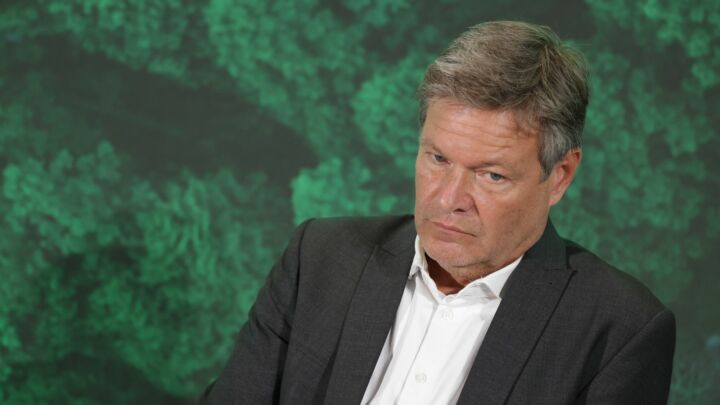What are the odds that we’re baking the planet?
Eco-campaigners claim that climate catastrophe is a virtual certainty. A little bit of maths and logic suggests otherwise.

Want to read spiked ad-free? Become a spiked supporter.
For some years now, governments, industry, and private citizens have been regularly chastised by environmental activists for not doing more to limit greenhouse gases, the presumed cause of global warming. But lately a far more serious charge has been made. In June, the oft-quoted NASA climate scientist James Hansen appeared before a United States congressional committee. He said that the directors of fossil-fuel companies ‘should be tried for high crimes against humanity and nature’ (1).
But these people shouldn’t be prosecuted just for producing fossil fuels. Hansen thinks they should also be prosecuted because, as he wrote in the UK Guardian: ‘Instead of moving heavily into renewable energies, fossil companies choose to spread doubt about global warming, as tobacco companies discredited the smoking-cancer link.’ (2)
In other words, fossil fuel company directors should be prosecuted for what they say, as well as for what they do.
It’s a common type of argument, familiar to anyone acquainted with totalitarian regimes: the nation (or revolution, race, class, etc) is in grave peril from (fill in the blank). But there are traitors among us who spread lies, seeking to weaken our resolve. They must be restrained (temporarily, of course) for the good of us all.
But there’s no reason this policy should only be applied to peddlers of coal and oil. Anyone who casts doubt on the reality of global warming would be equally guilty of imperilling the entire Earth. In the face of the imminent and overwhelming threat of catastrophic climate change, strict measures would (regrettably) have to be taken.
Environmental activists describe anyone who is sceptical of the urgent need to reduce greenhouse gases (GHGs) as a ‘climate-change denier’. The similarity of this phrase to the pejorative epithet ‘Holocaust denier’ is not accidental.
If you deny something, you believe it’s false. If you’re sceptical about it, you’re not convinced it’s true. This is an important logical distinction. But it’s one that environmental activists are happy to obscure.
It’s also important to distinguish the varying degrees of climate-change scepticism that exist. For example, someone might be sceptical about one or more of these commonly accepted statements:
- Global warming is really happening.
- Global warming is caused by man-made greenhouse gases (GHGs).
- Global warming will be harmful.
- GHG emissions must be reduced in order to combat global warming.
And if there really is an urgent need to reduce GHG emissions, all four of these statements must be true.
Predictably, James Hansen has no doubt: ‘I can assert that these conclusions have a certainty exceeding 99 per cent.’ (3)
But just how likely is it that all four of these statements are true? Fortunately, this question is easy to answer. All we need to do is consult the latest report of the Intergovernmental Panel on Climate Change (IPCC), along with an elementary logic textbook.
The IPCC Synthesis Report of 2007 is scrupulous in specifying the probability of the various statements it makes about climate change. For example, consider this sentence on page 30: ‘Average Northern Hemisphere temperatures during the second half of the twentieth century were very likely higher than during any other 50-year period in the last 500 years and likely the highest in at least the past 1,300 years.’ And this one on page 39: ‘Most of the observed increase in global average temperatures since the mid-twentieth century is very likely due to the observed increase in anthropogenic GHG concentrations.’ The italics are in the original.
Obviously this supports our statements 1 and 2. What the italicised words mean in terms of the percentage likelihood of causation or occurrence is clearly set out on page 27:
- 95-99 per cent: Extremely likely
- 90-94 per cent: Very likely
- 66-89 per cent: Likely
- 50-65 per cent: More likely than not
- 33-66 per cent: As likely as not
- Below 33 per cent: Unlikely
(The numbers given here for ‘more likely than not’ and ‘as likely as not’ aren’t misprints: the ranges overlap in the report itself.)
Now we’ll turn to our Logic for Beginners textbook. Suppose the two statements A and B are independent: that is, the truth of A doesn’t make B any more or less probable. Then the probability of them both being true is equal to the probability of A multiplied by the probability of B.
Consider the classic textbook example of the coin toss. The likelihood of tossing heads or tails when tossing a coin isn’t affected by previous tosses: no matter how many heads you’ve tossed already, the probability that the next will be heads is still fifty-fifty. (Many a gambler has come to grief by ignoring this basic principle.)
So the two statements:
A. The first toss is heads.
B. The second toss is heads.
are independent. Since the probability of each statement is 50 per cent, or 0.5, the probability of tossing two heads in a row is 0.5 x 0.5 = 0.25, or 25 per cent.
When the statements aren’t independent, the calculation is a bit more complicated. And obviously our statements 2, 3, and 4 aren’t independent of 1. But since the IPCC probability estimates take these dependencies into account, the simple multiplication rule of the coin toss example will give the correct result.
As we’ve seen, the IPCC rates statement 1 as ‘very likely’, so the probability of this statement is in the range 90-94 per cent. The IPCC also rates statement 2 as ‘very likely’. Using the multiplication rule, we can calculate the probability of statements 1 and 2 being true together as 81-88 per cent. This falls within the range the IPCC describes as ‘likely’.
So we can see already that James Hansen’s claim of ‘certainty exceeding 99 per cent’ goes well beyond the evidence provided by the IPCC report. It seems he’s placed himself firmly on the lunatic fringe of environmental activism.
Of course, this doesn’t mean that climate-change scepticism is warranted. The probability that statements 1 and 2 are both true is still over 80 per cent, according to the IPCC data. But statements 3 and 4 have to be considered as well. Again, all four must be true if the calls for urgent action on GHGs have any merit.
The IPCC report examines a number of scenarios that make different assumptions about world population and economic growth. For each scenario, it estimates how much average global temperature would rise by the end of the twenty-first century. These estimates range from 0.6 to 4.0 degrees.
The IPCC also estimates what effects these different levels of global warming might have on weather, food production, ecological systems, human health, and so on. For the most part, these effects are harmful ones, such as increased drought, heatwaves, floods, and more intense storms.
But some benefits are also mentioned. Under some of the scenarios, longer growing seasons and increased precipitation result in an overall increase in global food production. Warmer winters also have some health benefits, and significantly reduce energy consumption.
However, the IPCC report makes no predictions about how much future global warming will occur, since it doesn’t assign probabilities to any of these scenarios. Although some amount of warming is predicted in all of the scenarios, the report reveals much uncertainty about how harmful the effects might be.
Nevertheless, let’s do our best for the case against GHGs, and assign statement 3 to the IPCC’s ‘likely’ category. This gives it a probability range of 66-89 per cent.
Using the multiplication rule once again, we find that the probability of statements 1, 2, and 3 all being true is 53-79 per cent. This falls mainly within the range the IPCC describes as ‘more likely than not’.
Finally we come to statement 4. Given statement 2, it may seem obvious that reducing man-made GHGs would reduce global warming. But unfortunately, the physical world is more complicated than that. The fact that X is the cause of Y doesn’t guarantee that doing something to X will have any effect on Y. To choose a simple example, you can’t fix a broken window by getting rid of the rock that broke it. And many environmentalists – including James Hansen – talk ominously about ‘tipping points’, beyond which further global warming would be unavoidable whatever we did.
So there’s no guarantee that reducing man-made GHGs would have any effect on global warming. Still, let’s assume our statement 4 is also ‘likely’ to be true. Using the multiplication rule one last time, it turns out the probability of statements 1 through 4 all being true together is 35-70 per cent. This falls almost entirely within the range the IPCC calls ‘as likely as not’.
It’s easy to predict the environmentalist response: ‘We should err on the side of caution, and try to cut GHG emissions anyway.’ This would be perfectly reasonable if limiting GHGs would itself have no adverse consequences. But implementing policies like those set out in the Kyoto Protocol would have significant economic costs.
More strident environmentalists would no doubt like to tip this balance by replacing our statement 3 with something like: ‘Global warming will be catastrophic.’
But there’s nothing in the IPCC report that justifies such a claim. This puts it in the same league with statements like: ‘Man-made GHGs have saved us from another ice age.’ Based on the IPCC report, both statements are equally likely.
People are notoriously error-prone when reasoning about probability. When told that two statements are each very likely to be true, most people immediately conclude that the two taken together are just as probable. But this isn’t so. Claiming that two things are true just gives you twice as many opportunities to be wrong. Uncertainties multiply, however slight each individual one might be.
Science can’t always give us definite answers to our questions, even when the issues involved are very important to us. But it often can tell us how certain we should allow ourselves to be. And the certainty expressed by far too many environmentalists goes well beyond what the science will support.
DK Johnston is an adjunct professor of philosophy at the University of Victoria in British Columbia, Canada.
Brendan O’Neill denounced the idea that climate scepticism should be treated like blasphemy and argued against the politicisation of science. Rob Lyons noted Nigel Lawson’s criticism of the idea that the science is certain and discussed the wartime language of environmentalists. Or read more at spiked issue Environment.
(1) Put oil firm chiefs on trial, says leading climate change scientist, Guardian, 23 June 2008
(2) Twenty years later: tipping points near on global warming, Guardian, 23 June 2008
(3) Twenty years later: tipping points near on global warming, Guardian, 23 June 2008
Celebrate 25 years of spiked!
A media ecosystem dominated by a handful of billionaire owners, bad actors spreading disinformation online and the rich and powerful trying to stop us publishing stories. But we have you on our side. help to fund our journalism and those who choose All-access digital enjoy exclusive extras:
- Unlimited articles in our app and ad-free reading on all devices
- Exclusive newsletter and far fewer asks for support
- Full access to the Guardian Feast app
If you can, please support us on a monthly basis and make a big impact in support of open, independent journalism. Thank you.






Comments
Want to join the conversation?
Only spiked supporters and patrons, who donate regularly to us, can comment on our articles.